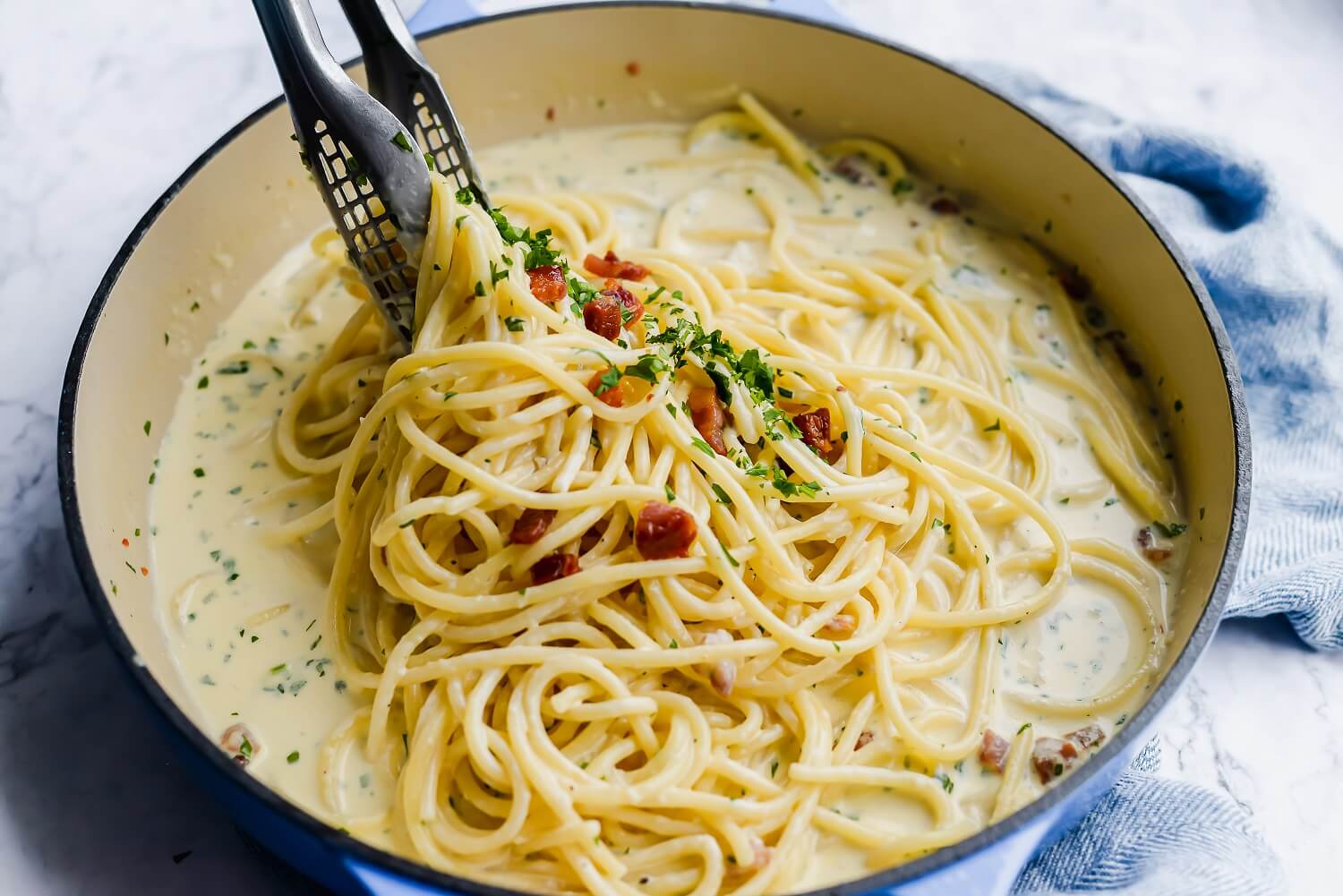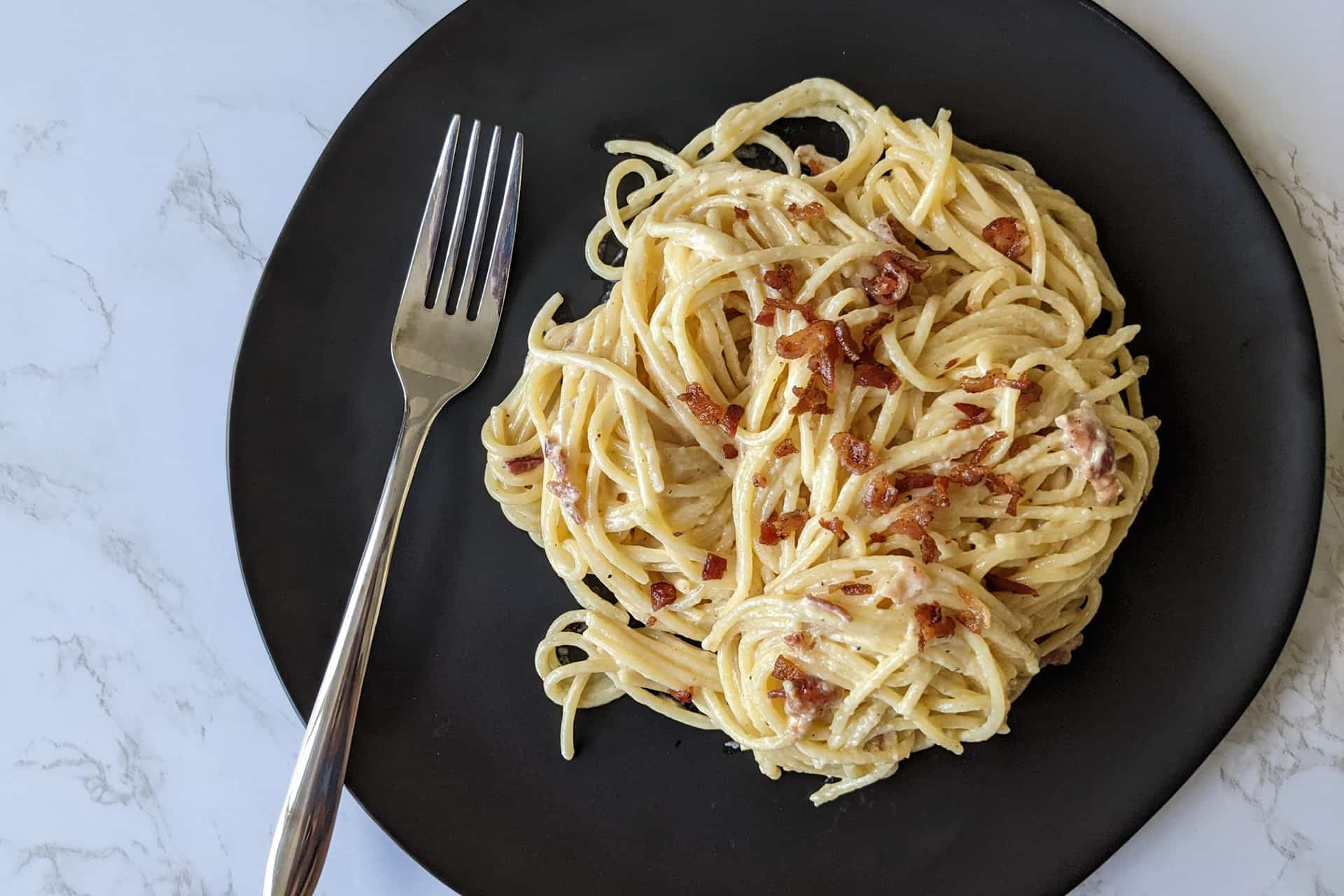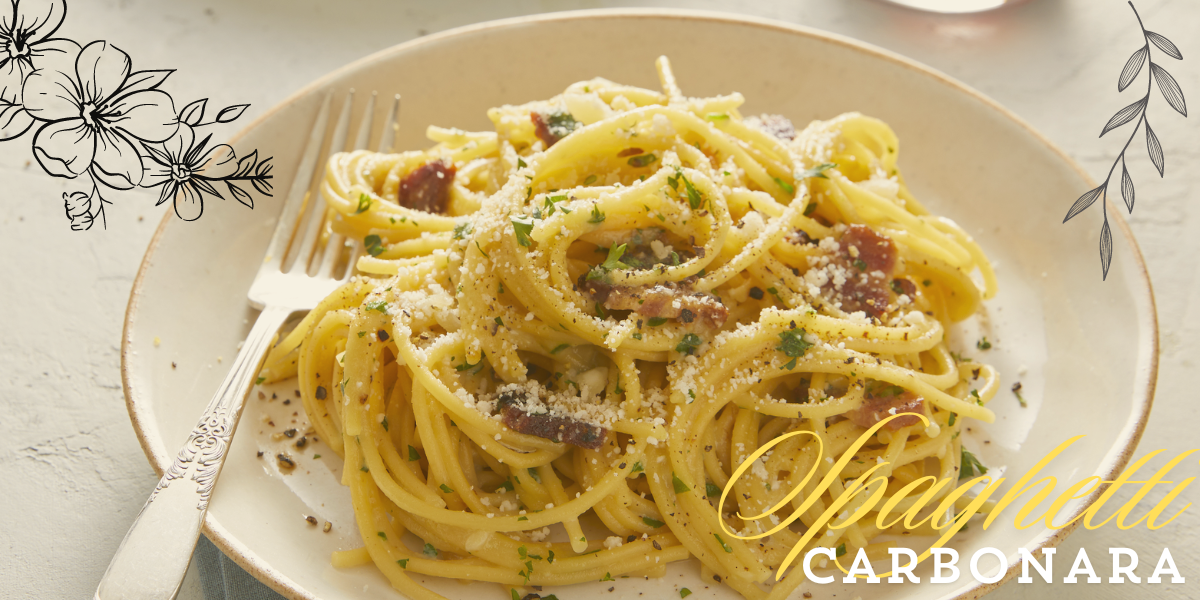To me, Spaghetti Carbonara is the quintessential Italian comfort food. This traditional Roman dish never fails to delight and uplift with its silky sauce adhering to al dente pasta, flecks of crispy pancetta or guanciale, and a liberal sprinkle of grated cheese and crushed black pepper.
A Journey Through History:
Spaghetti Carbonara’s creamy sauce is as enigmatic as its origins, which are both debated and buried in mystery. The dish may have been an ingenious culinary creation that sprang out of need in Rome in the middle of the twentieth century, according to a popular belief. Many attribute the dish’s creation to the Italian soldiers serving American rations of bacon and eggs who, according to legend, used the pasta that was available to them to make a filling dinner.
Carbonai, who worked as charcoal laborers in central Italy, made a dish similar to Carbonara using items like eggs, cheese, and cured pork. This is according to one school of thinking, but there’s another. Spaghetti Carbonara, with its simple yet profound flavor, has become a menu staple around the world, yet its exact origin is a mystery.

The Art of Preparation:
Spaghetti Carbonara may be a simple recipe, but it calls for dexterity and care to get the right texture—creamy without being overly heavy—and flavorful. Eggs, cured pig (usually pancetta or guanciale), Parmigiano-Reggiano or Pecorino Romano cheese, and freshly ground black pepper make up the traditional sauce that is mixed with spaghetti.
Start by boiling the pasta until it is just the right texture (al dente), then drain and set aside a cup of the starchy cooking water to use in the Spaghetti Carbonara recipe. Toss the pancetta or guanciale into a separate skillet and cook until it turns brown and crisp. This will impart the smokiness of the meat into the fat. Next, make a delicious sauce by whisking the eggs, cheese, and a little of the pasta water that was set aside.
The next important step is to combine the cooked pasta with the pork and egg combination that has been rendered, then remove it from the heat. Toss the pasta well to coat it with the velvety goodness. An egg sauce thick and velvety, cooked to perfection by the pasta and pancetta’s residual heat, coats the noodles in a sauce that won’t curdle. Freshly cracked black pepper, as a finishing touch, gives the meal a mild spice and fragrant richness.

Variations and Adaptations:
Spaghetti Carbonara allows for a great deal of personalization and creativity, even though purists may insist on following the traditional recipe to a T. When making a sauce, some cooks like to use heavy cream or butter for richness, while others like to add garlic, onions, or shallots for flavor.
There are many vegan and vegetarian versions of Carbonara that use plant-based ingredients like tempeh, tofu, or mushrooms to get the same rich umami flavor and velvety texture as the original. This classic Italian dish has been given a modern spin with inventive additions like smoked salmon, asparagus, and truffle oil, demonstrating the adaptability and diversity of Italian cooking.
Savoring the Experience:
Spaghetti Carbonara begs guests to relish every bite, whether they eat it at a busy trattoria in Rome or make it at home. As a result of its universal appeal and heartwarming simplicity, it brings people of all backgrounds together in a common love of good food and the simple joys of life around the table.
Why not make some Spaghetti Carbonara the next time you’re in the mood for something Italian? A little magic in the kitchen and a few simple ingredients can take you on a culinary adventure to the very center of Rome, where the history, emotion, and excess of each taste will be told. Have a good meal!
:max_bytes(150000):strip_icc()/MSL-341240-Quick-Carbonara-hero-3x2-6889-8c65cdf67f1149189b492c4def3c02e5.jpeg)
Classic Spaghetti Carbonara Recipe:
Ingredients:
- 400g (14 oz) spaghetti
- 200g (7 oz) pancetta or guanciale, diced
- 4 large eggs, room temperature
- 1 cup freshly grated Pecorino Romano cheese (or Parmigiano-Reggiano), plus extra for serving
- Freshly ground black pepper, to taste
- Salt, for pasta water
- Optional: Chopped parsley, for garnish
Instructions:
- Prepare the Pasta:
- Bring a large pot of salted water to a rolling boil. Add the spaghetti and cook according to the package instructions until al dente.
- Before draining, reserve about 1 cup of the pasta cooking water. This starchy water will help create a silky sauce later on.
- Cook the Pancetta:
- While the pasta is cooking, heat a large skillet over medium heat. Add the diced pancetta or guanciale and cook, stirring occasionally, until golden and crispy, about 5-7 minutes. Remove from heat and set aside.
- Whisk the Sauce:
- In a mixing bowl, whisk together the eggs, grated cheese, and a generous amount of freshly ground black pepper until well combined.
- Combine Ingredients:
- Once the pasta is cooked, drain it and immediately transfer it to the skillet with the cooked pancetta or guanciale. Toss the pasta with the pancetta/guanciale, allowing the rendered fat to coat the strands.
- Add the Sauce:
- Working quickly off the heat, pour the egg and cheese mixture over the hot pasta and pancetta/guanciale. Use tongs to toss everything together thoroughly, ensuring that the pasta is evenly coated in the sauce. If the mixture seems too thick, add a splash of the reserved pasta water to loosen it up.
- Serve:
- Divide the Spaghetti Carbonara among serving plates or bowls. Sprinkle each portion with additional grated cheese and freshly ground black pepper. Optionally, garnish with chopped parsley for a pop of color.
- Serve immediately, while piping hot, and enjoy the creamy indulgence of this classic Italian pasta dish!
Tips:
- It’s essential to work quickly when combining the hot pasta with the egg and cheese mixture to prevent the eggs from scrambling. Off the heat, the residual heat from the pasta will gently cook the eggs, creating a creamy sauce.
- Feel free to adjust the amount of cheese and black pepper according to your taste preferences. The beauty of Spaghetti Carbonara lies in its simplicity and versatility.
- For a vegetarian version, you can omit the pancetta or guanciale and use olive oil instead to sauté some garlic for flavor.
- Leftovers can be stored in an airtight container in the refrigerator for up to 2 days, though Spaghetti Carbonara is best enjoyed fresh. Reheat gently in a skillet with a splash of water to revive the creaminess of the sauce.

Interesting facts about Spaghetti Carbonara:
Controversial Origins:
Culinary historians disagree on where the dish first appeared. Opinions vary as to who really invented it: carbonai, the Italian charcoal laborers of the Apennine mountains, or American soldiers stationed in Italy during WWII. No matter where it came from, Spaghetti Carbonara has become a classic Italian meal.
Roman Roots:
Despite its immense popularity, Spaghetti Carbonara is often linked to Roman cuisine, namely that of the Lazio region. Its creamy richness is a mainstay on the menus of trattorias and restaurants all across the city, satisfying both locals and tourists.
Simple Ingredients, Bold Flavor:
One of the things that makes Spaghetti Carbonara unique is how simple the ingredients are, yet the flavor is bold. Pasta, eggs, cured pork (also called pancetta or guanciale), cheese (commonly Pecorino Romano or Parmigiano-Reggiano), and black pepper are the main components of the dish. These seemingly insignificant components add up to a meal with more flavor than the sum of its parts when they are mixed together.
The Role of Eggs:
When making Spaghetti Carbonara, eggs are vital since they form the foundation of the creamy sauce that covers the spaghetti. Gently cooking the eggs with the hot cooked pasta and rendered pancetta or guanciale fat makes for a velvety texture that doesn’t require heavy cream.
Timing is Key:
Time is of the essence when making Spaghetti Carbonara. In order to avoid scrambling the eggs, it is crucial to immediately remove the cooked pasta from the heat and combine it with the egg and cheese combination. As the pasta cooks a little longer, the eggs cook down into a rich sauce that coats the noodles.
Regional Variations:
Although purists cling to the original Spaghetti Carbonara recipe, there are many regional variants and contemporary takes on the traditional pasta dish. While some chefs experiment with different proteins or vegetarian-friendly alternatives, others add items like garlic, onions, or cream to give their dishes more depth of flavor.
An International Favorite:
Not Only Popular in Italy, But Around the World, Spaghetti Carbonara Is a Fan Favorite. It has become a global phenomenon, appearing on the menus of both upscale Italian restaurants and home kitchens across the globe. Pasta lovers all across the world go to it for comfort because of its rich and pleasant flavors.
Cultural Influence:
Spaghetti Carbonara has been mentioned in many works of art, films, and literature. Thanks to its appearances in books, movies, and TV series, it has become an iconic symbol of American cuisine that will last for generations.
Honoring Tradition:
Preparing Spaghetti Carbonara is seen by many Italians as an art form, despite its seeming simplicity. The traditional methods and flavors of this cherished dish are carefully preserved by chefs and home cooks alike, guaranteeing that it will be passed down for centuries to come.
A Taste of Italy:
Spaghetti Carbonara, whether eaten in a busy Rome trattoria or tenderly made at home, showcases the Italian culinary tradition. The capacity to bring back warm memories, satisfy longings, and pleasure the taste buds with each bite is what gives it its enduring allure.

(FAQs) about Spaghetti Carbonara:
Q. What is Spaghetti Carbonara?
- A traditional pasta dish with Roman origins, Spaghetti Carbonara is a favorite among Italians. In it, cured pig (commonly pancetta or guanciale), eggs, cheese (usually Pecorino Romano or Parmigiano-Reggiano), and black pepper are combined with spaghetti noodles in a creamy sauce.
Q. What does “Carbonara” mean?
- This “Carbonara” comes from the Italian “carbonaro,” meaning “charcoal burner.” Some think it alludes to the dish’s history with charcoal workers in Italy, while others point to the black pepper’s resemblance to charcoal flecks as the reason.
Q. What are the traditional ingredients in Spaghetti Carbonara?
- Pasta, eggs, cheese (Parmigiano-Reggiano or Pecorino Romano), pancetta (cured pork), and black pepper are the classic components of Spaghetti Carbonara.
Q. Is cream used in authentic Spaghetti Carbonara?
- Spaghetti carbonara made the right way does not call for cream. The sauce’s velvety texture is achieved by emulsifying the starchy pasta water with eggs and cheese, which gives the sauce its creaminess.
Q. Can I use bacon instead of pancetta or guanciale?
- If you can’t find pancetta or guanciale, you may use bacon instead. It adds the same flavor and texture to Spaghetti Carbonara, but it’s not always available. Having said that, there might be a little variation in flavor.
Q. How do I prevent the eggs from scrambling in Spaghetti Carbonara?
- Make sure to remove the cooked pasta from the heat before adding the egg and cheese mixture; otherwise, the eggs will scramble. Eggs will be cooked to perfection in the creamy sauce without scrambling thanks to the pasta’s residual heat.
Q. Can I make Spaghetti Carbonara ahead of time?
- To preserve the sauce’s velvety texture, Spaghetti Carbonara is best eaten right after cooking. You can reheat leftovers in the oven, but the sauce might get thick and lose its creamy texture.
Q. What are some variations of Spaghetti Carbonara?
- Spaghetti Carbonara has many iterations and adjustments, but the original dish is still a favorite. Some versions try other proteins or vegetarian-friendly alternatives, while others include extra ingredients like garlic, onions, mushrooms, or peas.
Q. Is Spaghetti Carbonara suitable for vegetarians?
- Pasta carbonara traditionally made with cured pork (guanciale or pancetta) is not suited for vegans. However, if you want to make it vegetarian-friendly, just leave out the meat and add some mushrooms or tofu for texture and taste.
Q. What dishes pair well with Spaghetti Carbonara?
- Salads, garlic bread, antipasto platters, and Italian wines like Pinot Grigio and Chianti go wonderfully with Spaghetti Carbonara. You may make it a more substantial dinner by serving it with grilled meats or vegetable side dishes.
conclusion:
Finally, the enduring talent of Italian chefs is on full display in Spaghetti Carbonara. People all across the globe love it because of its cozy appeal, simple yet tasty ingredients, and long history of use. The creamy sauce, flavorful cured pork, and delicate balance of tastes in Spaghetti Carbonara have captivated diners for generations, from its disputed origins in Rome to its broad popularity today. This renowned dish is a celebration of tradition, delicious cuisine, and shared meals, whether eaten at a busy trattoria, made with love at home, or relished in imaginative retellings. Indulge in the simple yet profound delights of a cuisine that transcends time and borders with each forkful of Spaghetti Carbonara, with its silky noodles and creamy sauce.
THANKS FOR READING
READ MORE :-The Enchanting Allure of Cacio e Pepe Egg Noodles: A Delicate Romance
